#Diprotodon
Explore tagged Tumblr posts
Text


Australian megafauna. Found book plate.
Marsupials including thylacine, thylacoleo and diprotodon.
84 notes
·
View notes
Text

i’ve had this concept on my mind all week and i finally sat down and drew it: enjoy my chappell roan diprotodon
37 notes
·
View notes
Text
Weretober 2023 - Part 2: Lives of the Werebeasts of Urvara

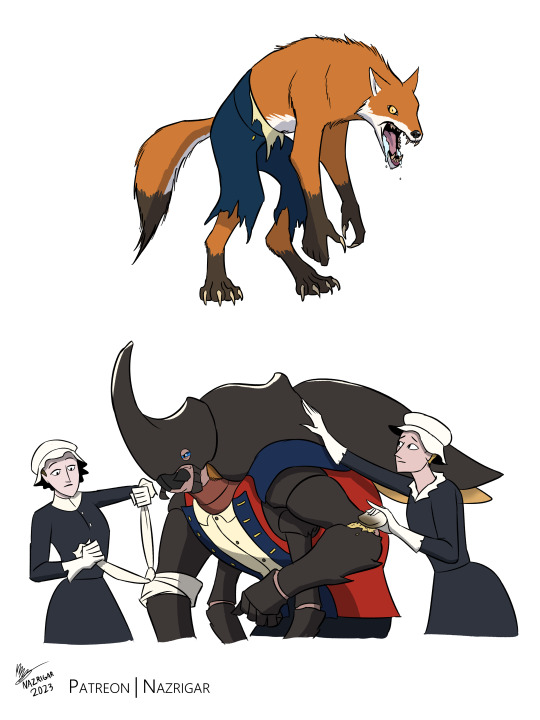
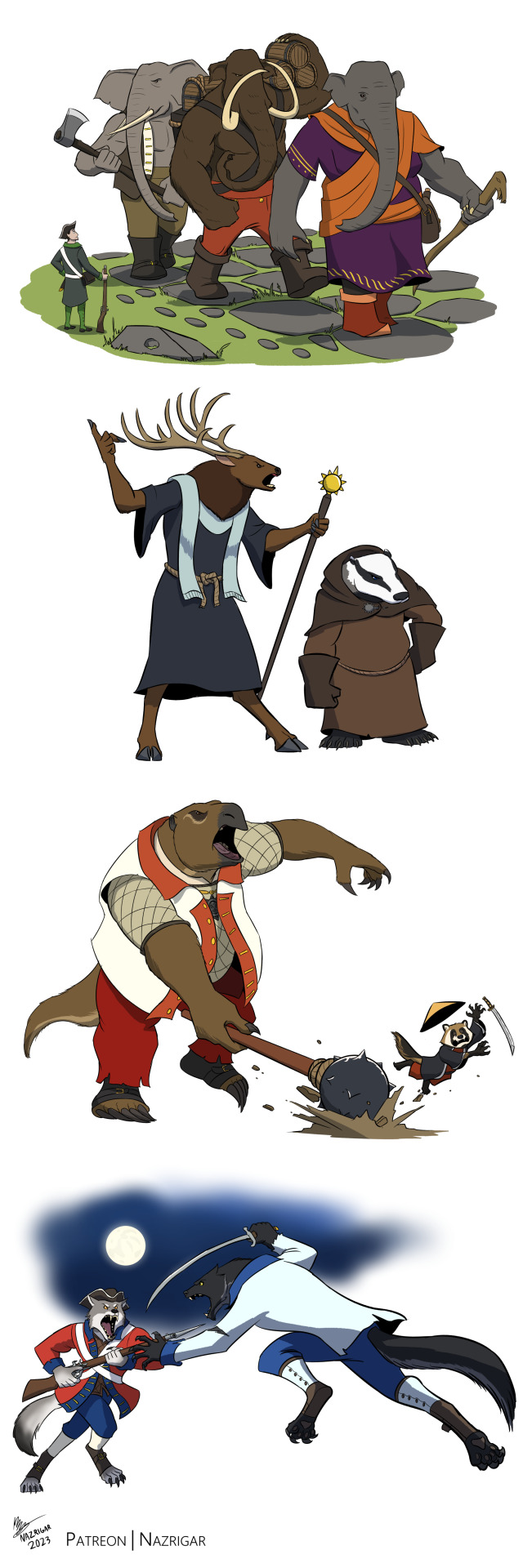
And now, to cap off Weretober 2023, the final batch exploring the lives of Werefolk in my setting of Beast Fables. From assassins to soldiers to ronin to nasty diseases, there are many sides to being a werebeast in Urvara!
A famous Were-Tarantula Hawk assassin readies for combat against a berserker were-shrew.
A were-sea lion stumbles upon a rare find: a black pearl! Surely this will give her clan honor! Unbenkowest to her however, she is being watched by a couple of merfolk. The Mer-tiger shark wants to "deal" with her, to keep their society a secret, but the Mer-octopus urges caution instead.
For most people, a person's animal form is either from one parent or the other. In much rare cases however, one could get an animal form that's a hybrid of their parents's beast form! Walter Raja Surrey here is a Liger, and has all of the hybrid's advantages, without the myriad of health problems associated with them!
A member of the last group of Were-Diprotodons shows an archeology student and an art history student an example of a hunting boomerang, otherwise known as a karli. Alongside being both a great example of art and a useful tool, it's big enough to double as a club.
A werefox succumbs to that most feared of diseases among were-mammal kind, rabies. Certain were-folk, like werebirds can fight off the disease, while others like were-crocodilians seem to be immune to almost anything.
A were-rhinoceros beetle gets treated for cordyceps. While not the lethal, muscle and nervous system hijacker of their wild counterparts, it still hurts, and requires immediate attention, lest it begins to interfere with the magics governing transformation as well as tissue damage.
A traveling group of were-elephantines, including a mammoth. While giants to a regular person, they themselves are dwarfed by the creator of the roads they travel upon, called the Titan Roads. These roads were built by Were-sauropods.
A turbulent priest preaches the cause for justice, and the betterment of society as a whole. A priest of the Ten Faced God, he dons the silver and black to denote his devotion to the face of Justice.
A were-raccoon dog ronin thought his speed and agility would win the day against the lumbering were-eremotherium, who himself is in service of a large empire known as Tartessos (basically Not!Spain). The risk the ronin took was calculated, but BOY was he BAD at math!
And finally, the classic Werewolf. A Durroyan werewolf charges with a bayonet, steely determination in his eyes and faith that discipline will win the battle through. A Gevaudanois werewolf counter charges with tooth, claw and sabre in hand, confident that courage and ferocity will win the day.
#my art#weretober#weretober 2023#fantasy worldbuilding#worldbuilding#werewolf#diprotodon#mammoth#loxodon#elephant#mermaids#beast fables#nazrigart#creature design
124 notes
·
View notes
Text
Links for propaganda. Deltasaurus, a triassic temnospondyl amphibian

Diamantinasaurus, a cretaceous sauropod dinosaur

Dickinsonia, an ediacaran ah well yeah ummm ok probably animal
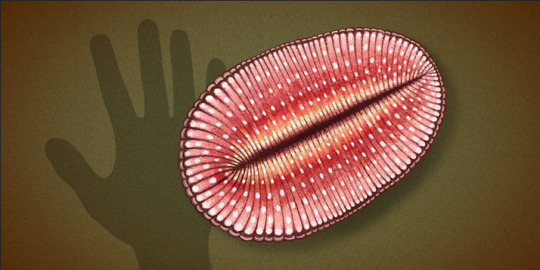
Diluvicursor, a cretaceous ornithopod dinosaur
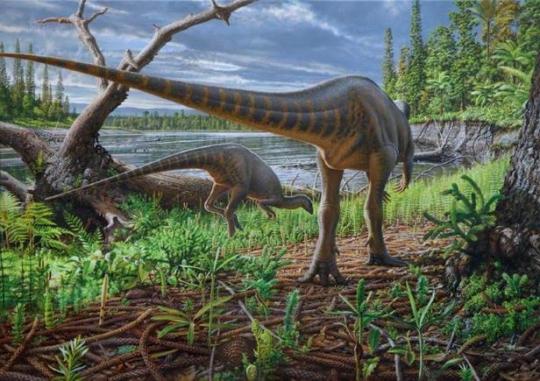
Diprotodon, a pleistocene diprotodontid marsupial
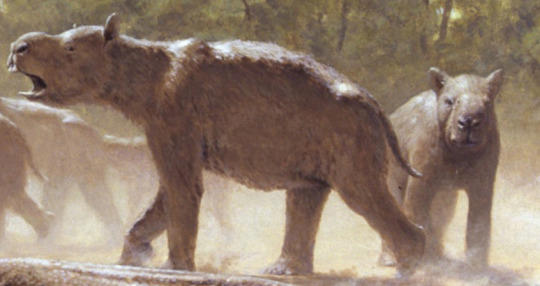
Dromornis, a cenozoic dromornithid bird
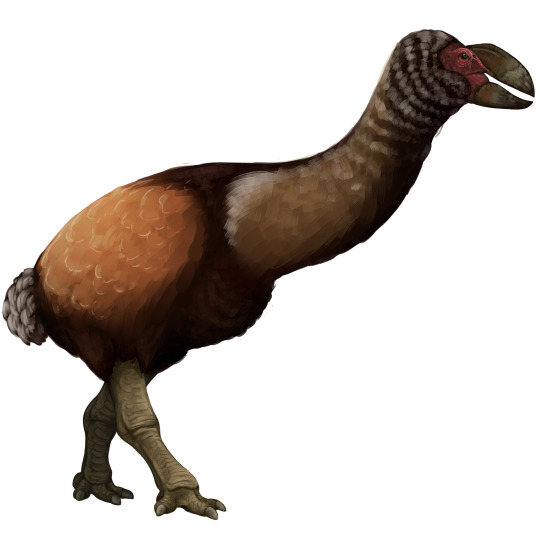
#please reblog#feel free to advocate for your favourite#palaeoblr#australian fossil alphabet thing#dinosaur#megafauna#deltasaurus#diamantinasaurus#dickinsonia#diluvicursor#diprotodon#dromornis
51 notes
·
View notes
Text

Paleovember 2023, Diprotodon!
To add to the list of Australian Megafauna, we have this guy! Weighing in at 3 tons and standing five feet at the shoulder, this extinct relative of wombats and koalas stands as the largest known marsupial to have ever existed. Equipped with a powerful set of jaws, Diprotodon was able to eat a wide array of tough vegetation, as well as fend off predators like Thylacoleo. It went extinct about forty thousand years ago due to increasing desertification as well as the arrival of humans. However, there are some who conjecture that some Aboriginal myths retain the memory of Diprotodon long after it's disappearance!
#Diprotodon#wombat#koala#marsupial#australia#pleistocene#ice age#paleontology#paleoart#art challenge#artwork#animal#illustration#art#cartoon#digitalart#drawing#procreate#prehistoric#artist on tumblr
50 notes
·
View notes
Text

Diprotodon, 1988
23 notes
·
View notes
Text

Sketches of the iconic Australian animals that were part of the Pleistocene Megafuana, from top to bottom: Procoptodon goliath, Megalania prisca, Diprotodon opatum and Thylacoleo carnifex.
#paleoart#paleontology#pleistocene#pleistocene megafauna#diprotodon#megalania#procoptodon#thylacoleo#australia#cenozoic#cenozoic life
47 notes
·
View notes
Text

sketchbook 25.09.2023
#my art#sketchbook#traditional art#paleoart#smilodon#diprotodon#thylacasmilus#plateosaurus#and the still extant#blue whale#image id in alt text
18 notes
·
View notes
Text
'Diprotodon, as restored by Professor [Frederick] McCoy, with a large Dingo, or native dog'
The Leader [Australia], 10th May, 1862, pg. 1
https://trove.nla.gov.au/newspaper/article/196392797?searchTerm=diprotodon

10 notes
·
View notes
Text
day 17, dont have repenomamus either so i grabbed other critters




17 notes
·
View notes
Text

A worn fossilized tooth of a Diprotodon optatum or the giant wombat from Glen Innes, New South Wales, Australia. Diprotodon is currently the largest known marsupial to exist, and went extinct around the end of the Pleistocene.
#synapsid#mammal#fossils#paleontology#palaeontology#paleo#palaeo#diprotodon#wombat#marsupial#pleistocene#cenozoic#prehistoric#science#paleoblr#ディプロトドン#化石#古生物学
26 notes
·
View notes
Text
So everyone loves Megalania (Varanus priscus), the giant monitor lizard from Pleistocene Australia. But here's something I found out today. For a brief period of time in the 1880s Richard Owen, the guy who described it, thought it was a giant spiny lizard similar and possibly related to the Thorny Devil. At that time this reconstruction was created.

The reason is about as dumb as you would think. So while Megalania was originally described based on a few vertebrae, Owen was beginning to referr more and more material to the animal, a lot of the time without the bones showing any overlap. Now around 1880 the skull of the giant turtle Ninjemys was found in Australia and sent to Owen in London. G. F. Bennett, who found the skull, correctly identified it as a turtle and mentioned as much in a letter to Owen.


Except Owen seemingly ignored that or disagreed, because he swiftly proposed that the skull was actually that of a lizard and not just that, specifically that of Megalania. As if that wasn't already an unholy chimera enough for you, the limb bones that Owen assigned to Megalania at the time were those of a GODDAMN MARSUPIAL. Not even a reptile.
Even when studying more turtle skulls from Lord Howe Island, Owen insisted that what he had were actually lizards, which he considered to be relatives of Megalania (naming them Meiolania). Eventually both Huxlay and Woodward got involved, recognizing the two skulls as turtles and removing all the non-lizard stuff from Owen's Megalania. But for just a brief period of time Megalania was some uncanny hybrid between monitor lizard, giant wombat (art by Gabriel Ugueto) and tail-clubed turtle (art by Joschua Knüppe)
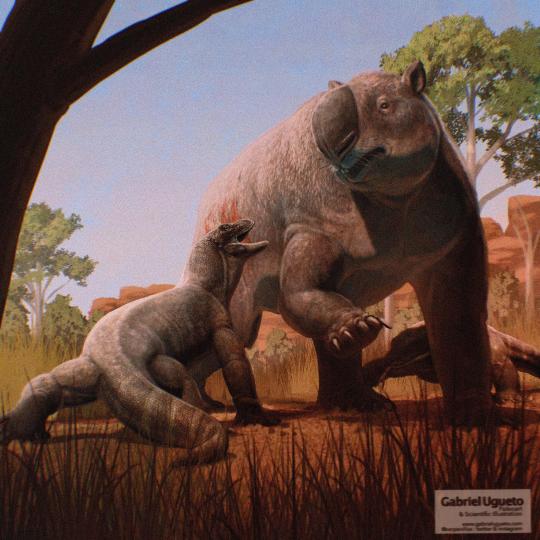
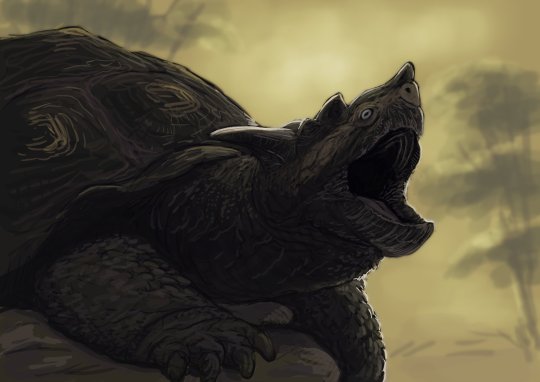
#megalania#varanus#varanus priscus#monitor lizard#ninjemys#meiolania#diprotodon#australia#richard owen#palaeblr#paleontology#prehistory#pleistocene#history#paleontology history
69 notes
·
View notes
Text
I'm a fan of fakemon, fan-made Pokemon, and how creative they can be. I've come up with some ideas of my own for a fakemon region based on a mix of Australia and Aotearoa/New Zealand and I want to share them. I've also been learning how to use a drawing tablet and have made some concept art. I am very bad at drawing, but it's something. I'll start with the starters.
The grass starter is Womaca, the wombat Pokemon, grass-type. It is based on a combination of a wombat, a glyptodon, and a macadamia nut.

They eat so many nuts that a hard nut shell grows on their backs. They are shy creatures that rarely leave their burrows and never venture too far away. If threatened, it will dig into the group and hunker down, leaving only its shell exposed. Its name comes from "wombat" and "macadamia".
Womaca evolves into Petramaca, the wombat Pokemon, grass/rock type. The nut shell on its back has hardened into petrified wood, increasing its defenses. Because of this, it is braver and will venture farther from its den, but is still easily startled. The moss growing on its shell has medicinal properties. Its name comes from "petrified wood" and "macadamia".

The final stage is Dipwoodoo, the diprotodon Pokemon, grass/rock type. It is based on the diprotodon, a giant, extinct wombat relative and hoodoos, my favorite geological feature. They are tall spires of rock formed when soft rock erodes away, leaving harder rock behind. Its name comes from "diprotodon", "petrified wood", and "hoodoo"

Dipwoodoo now has little fear as its size and shell give it few natural predators. It is now a gentle giant that no longer fears leaving its shelter and rarely picks fights. Ancient people used to carve petroglyphs into its shell.
For the fire starter, I went back to the idea that most fire starters are based on animals from the Chinese zodiac. For an Australia-based region, what else could I use but a dingo? The whole line is based on aboriginal lore where dingos were seen as companions and guardians who often protected people from evil spirits.
The first stage is Dingup, the dingo Pokemon, fire-type. Its name comes from "dingo" and "pup". It acts brave, but is often shy. It seems to notice things that nobody else does, making people believe it can see spirits.

The second stage is Dingunji, the dingo Pokemon, fire-type. Its name comes from "dingo" and "bunji", a work in multiple indigenous languages that means "close friend" or "kinsman" It is wild and rebellious, but truly values its friends and will always remember its home, no matter how far away it roams. It is believed to chase dangerous spirits away from its friends.

If Dingunji is the rebellious teenager stage of the line, then the final form of Warrighul (the shaman Pokemon, fire/psychic type) is the adult who has settled down and rejoined the community. It is much calmer than Dingunji and acts as a guardian of its community, protecting them from dangerous spirits. Its flame can be seen in both the real world and the spirit world and can burn spirits, causing them to flee. At the same time, it can commune with friendly spirits and will act as an aid to shamans. It's name comes from "warrigal" (another word for dingo), "warg" (supernatural wolves in norse mythology), and "ghoul".

Finishing with the water starter line, I've given this one more of a Maori basis and I'm kind of concerned about it possibly being insensitive so if anyone out there is or knows Maori and reads this, let me know what you think, please. I mean absolutely no disrespect. This line is based on the platypus and all three are water/poison type due to male platypuses having venomous spurs on their hind feet.
The first stage is Platox, the platypus Pokemon. It is a skilled swimmer, but is clumsy and slow on land. All four of its feet have retractable red spurs that inject venom into whatever they stab. Its name comes from "platypus" and "toxic".

The second stage is Platypatu, the platypus Pokemon. It can now stand on two legs or four and has become much more adept on land. Its spurs have become Assassin's Creed-style retractable wrist blades. Its tail is shaped like a patu, a Maori weapon shaped like a paddle, and can be used as a club. It fights in a dancing motion, striking with its tail and spurs. Its name comes from "platypus" and "patu".

The final form is Hakotiave (may shorten that), the dancing Pokemon, and it's where my poor art skills really show. It's supposed to look like a buff humanoid but you'll have to use your imagination. Its name comes from "haka" (traditional Maori dances"), "kotiate" (another Maori weapon), and "venom". It it known for its love of dance and has distinct dances for every occasion, including celebration, communication, and intimidating enemies. When two fight, they will have a dance battle until one submits. They fight in graceful dancing motions using their retractable spurs and kotiate-shaped tails. It has curved markings on its face and body that grow darker as it gains more experience. These are based on Maori Tā Moko tattoos.

That does it for my starters, at least the first set. There will be a second set similar to how in X and Y you can pick one of the Kanto starters partway through the game. Those will have to wait for another post. That is, if anyone is interested in seeing more of my fakemon. I also have some OC Digimon I need to draw sometime.
15 notes
·
View notes
Text

WOMBATS. BEST ANIMAL. Two of these bad boys did exist, one of them basically existed I've just exaggerated the bit that has probably been disproven, and the last one still does exist. I love wombats. I'm so sad the other ones are all long since extinct. How cool would it be if diprotodon still existed? omg.

Speaking of, the beeg boy, diprotodon. Speaking of, the Kazinians just call them 'giant wombats' because Latin names will make no sense in Tsyllaes. Giant wombats are about 2m tall at the shoulder and, in the southern mountains, they're used to do strong things like plow fields, pull tree stumps out of the ground, drag entire trees along to where they need to be milled. Cos look, you can't prove to me diprotodon wasn't tameable, and this is my world and I'm putting farming giant wombats in it. Yes, I know I already have draft makakis, I don't care, diprotodons are stronger.

Zygomaturus, which doesn't appear to have a common name so far as I can find, so Kazin calls this one the rhinobat, because it's about the size of the Llayan rhino (which may or may not look like a modern rhino, idk, I'll get to them) and its snoot does the thing where it goes up like a horn! I have no real reason for these guys to exist except that they look funny and I like the progression down to wombat. Rhinobats live in the tropics and do the same heavy work of the diprotodons in the southern mountains.
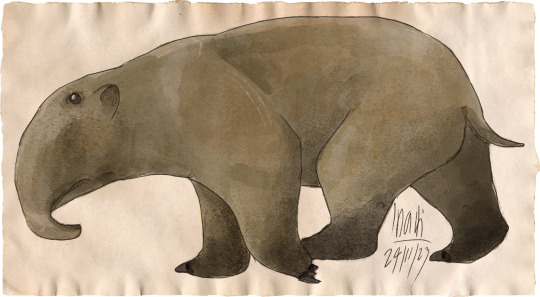
Palorchestes Azael, which I will never in my life be able to remember and anyway this isn't 100% it, so. The makabat, cos it has a trunk! Maybe. General consensus now seems to be it had more of an elongated top lip, more like a giraffe, rather than a trunk, but in my world with makakis I like to have a bit of a connection. Plus it's not like I'm ever going to use its Latin name, anyway. I feel like they might be farmed for meat? Idk. We don't eat wombats, which may be because they're nowhere near as common as kangaroos or because they just aren't good eating, but idk. These guys don't exist anymore so whatever, I do what I want. Maybe they're tough and you need a lot of garlic but you'll get there in the end.
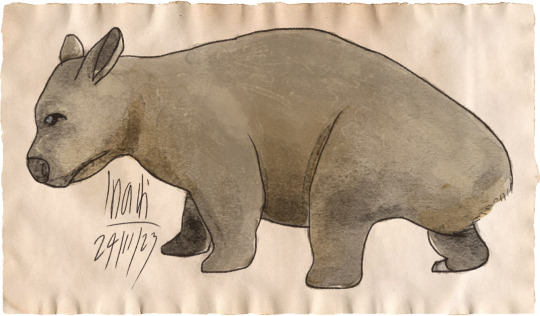
Which brings us to the good ol' wombat <3 I love wombats so much. This is a southern hairy-nosed wombat specifically, with him long floofy butt and longer nose than the common wombat, which is your more traditional perfect wombat face. Hairy-nosed wombats are derpier and therefore better. Common wombats also exist in Kazin but I wanted to draw hairy-nosed.
2 notes
·
View notes
Photo

fuck procoptodon
#my art#prehistory crap#dromornis#diprotodon#procoptodon#I'm gonna draw a full body procoptodon one day because it's full on the worst mammal ever I think
5 notes
·
View notes
Text

Bunyip
Altura: 200 metros
Longitud: 300 metros
Peso: 92,400 toneladas
Primer Avistamiento: Ayers Rock [Tierra: Teratoverso]
Controles: Tierra Control [Excavación Camuflaje] Fuego Control [Haz de Uranio] Agua Control [Nado]
Guarida: Ayers Rock [Tierra:Teratoverso] Pantano Brumoso [Avatarverso]
Aspecto: Diprotodon + Alce (Cornamentas)
Aliados:
Humanos: Aang, Katara, Soka, Iroh, Zuko
Kaijus y otras bestias: Anguirus, Baragon, Mothra, Rodan, Godzilla
Enemigos:
Humanos: Ozai y Azula
Kaijus y otras bestias: King Ghidorah
#avatar aang#avatar: the last airbender#avatarverse#kaiju#monsterverse#godzilla king of the monsters#diprotodon#moose#cgi#cryptozoology#australia#bunyip
2 notes
·
View notes